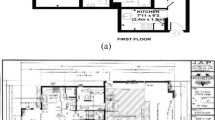Abstract
In the field of architecture, floor plan design is the way to generate various floor plans for houses. Designing of floor plan is one of the most essentials for all kinds of infrastructures. In spite of this, there are many computerized and manual ways are available today. Nowadays, the burden of manual work has been greatly reduced. Even though the manual works have been greatly reduced, still there are some manual works like dragging and dropping, aligning the rooms, placing in desired locations, etc. We cannot determine the exact lengths of rooms, hall, kitchen, etc. Floor plan designing is one of the highly iterative processes and it demands extensive human labour; however, they are limited to fully automate the creative process. This proposed work faces so many real challenges because of the many implicit and explicit rules in order to create viable floor plans. In this work, a floor plan designer is suggested for an automated floor plan generating application that can generate floor plans automatically when the total area of the land and choice of BHK (B = Bedroom. H = Hall. K = Kitchen) is provided by the customers. In this research work, deep convolutional neural network (DCNN) methods are proposed to handle floor plan parsing and spatial recognition methods. Spatial recognition [1] among objects plays a fundamental role in the human perception and understanding of design. The various spatial recognition methods are used to edit the generated floor plans based on their willingness and acceptance.
Access this chapter
Tax calculation will be finalised at checkout
Purchases are for personal use only
Similar content being viewed by others
References
Ostwald, M.J.: The mathematics of spatial configuration: Revisiting, revising and critiquing justified plan graph theory. Nexus Netw. J. 13(2), 445–470 (2011)
Liu, C., et al.: Raster-to-vector: revisiting floor plan transformation. In: Proceedings of the IEEE International Conference on Computer Vision, pp. 2195–2203 (2017)
Ozler, L.: AutoCAD WS for Android (2011)
Wang, H., et al.: Graphgan: graph representation learning with generative adversarial nets. In: Thirty-Second AAAI Conference on Artificial Intelligence (2018)
Jia, Y., Shelhamer, E., Donahue, J., Karayev, S., Long, J., Girshick, R., Guadarrama, S., Darrell, T.: Caffe: Convolutional Architecture for Fast Feature Embedding (2014)
Michalek, J., Choudhary, R., Papalambros, P.: Architectural layout design optimization. In: Engineering Optimization, pp. 461–484 (2002)
Good, I., et al.: Generative adversarial nets. In: Advances in Neural Information Processing Systems, pp. 2672–2680 (2014)
Tom Ravenscroft.: Wallgren Arkitekter and BOX Bygg Create Parametric Tool that Generates Adaptive Plans (2019)
delas Heras, L.P., Terrades, O., Robles, S., Sanchez, G.: A new database for structural floor plan analysis and its ground truthing tool. Int. J. Doc. Anal. Recogn. (2015)
Jaques, N., et al.: Generating music by fine-tuning recurrent neural networks with reinforcement learning. In: Deep Reinforcement Learning Workshop NIPS (2016)
Okoi, M.: FreeCAD—A 3D Modelling and Design Software for Linux (2019)
Author information
Authors and Affiliations
Corresponding author
Editor information
Editors and Affiliations
Rights and permissions
Copyright information
© 2022 The Author(s), under exclusive license to Springer Nature Singapore Pte Ltd.
About this paper
Cite this paper
Rajasenbagam, T., Jeyanthi, S., Uma Maheswari, N. (2022). Floor Plan Designer Application by Predicting Spatial Configuration Using Machine Learning. In: Joshi, A., Mahmud, M., Ragel, R.G., Thakur, N.V. (eds) Information and Communication Technology for Competitive Strategies (ICTCS 2020). Lecture Notes in Networks and Systems, vol 191. Springer, Singapore. https://doi.org/10.1007/978-981-16-0739-4_63
Download citation
DOI: https://doi.org/10.1007/978-981-16-0739-4_63
Published:
Publisher Name: Springer, Singapore
Print ISBN: 978-981-16-0738-7
Online ISBN: 978-981-16-0739-4
eBook Packages: Intelligent Technologies and RoboticsIntelligent Technologies and Robotics (R0)




